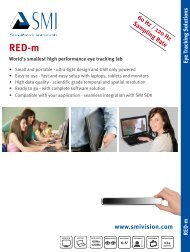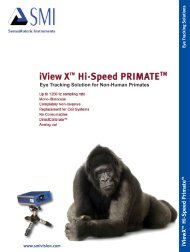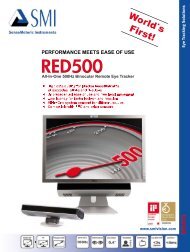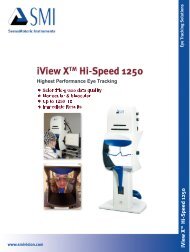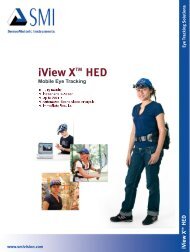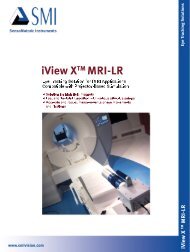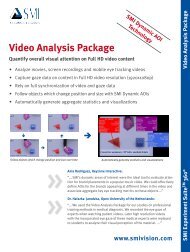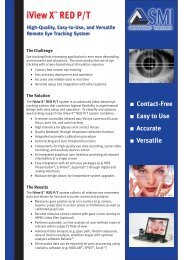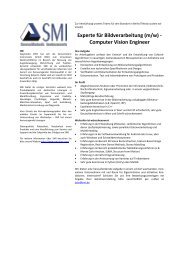Case Study Eye Tracking: Measuring Brand Recall - SMI
Case Study Eye Tracking: Measuring Brand Recall - SMI
Case Study Eye Tracking: Measuring Brand Recall - SMI
You also want an ePaper? Increase the reach of your titles
YUMPU automatically turns print PDFs into web optimized ePapers that Google loves.
<strong>Case</strong> <strong>Study</strong> <strong>Eye</strong> <strong>Tracking</strong>:<br />
<strong>Measuring</strong> <strong>Brand</strong> <strong>Recall</strong><br />
Preliminary conclusions about parameters that increase advertising impact of product placement can be drawn from<br />
a pilot study with <strong>SMI</strong> remote eye tracking technology using <strong>SMI</strong>’s advanced video analysis tools. The usability consultant<br />
KeyLime Interactive captured attention data over Lady Gaga’s award winning music video “Bad Romance”.<br />
BACKGROUND<br />
Product placement has been part of<br />
the marketing communication mix for a<br />
century. Consistent growth is reported<br />
on spending for this methodology.<br />
Most consumers (69%) accept brand<br />
integration in TV, movies and video<br />
games as long as they do not recognize<br />
a disruption in their viewing or user<br />
experience. But an ongoing question is<br />
how to measure the advertising impact<br />
of product placement.<br />
This discussion was fueled by the<br />
release of the latest album of US pop<br />
star Lady Gaga. The music videos of the<br />
songs featured an extensive number of<br />
embedded products.<br />
The usability consultant KeyLime Interactive<br />
used <strong>SMI</strong>’s eye tracking technology<br />
to assess advertising impact of<br />
product placements within the music<br />
video “Bad Romance”.<br />
www.keylimeinteractive.com<br />
www.smivision.com/egts<br />
CHALLENGE<br />
<strong>Brand</strong> managers want to know which<br />
are the factors that determine the<br />
impact of placing products in entertainment<br />
programming: be it gaming,<br />
music videos or television shows.<br />
To further understand the attention<br />
these embedded products demand,<br />
methodology needs to go beyond<br />
traditional testing with observation<br />
or post-exposure questionnaires.<br />
SOLUTION<br />
KeyLime Interactive conducted a pilot<br />
study using <strong>SMI</strong> remote eye tracking to<br />
capture attention data over the award<br />
winning music video “Bad Romance”.<br />
The objective was to determine if<br />
there were trends in size of branded<br />
products or length of exposure that<br />
reliably result in product recall.<br />
Ania Rodriguez, KeyLime Interactive:<br />
CONCLUSIONS<br />
Important predictors of visual<br />
attention are frequency of product<br />
appearance but not display size.<br />
The relationship between the amount<br />
of time participants dwelled on a product<br />
and the number of appearances<br />
that product made explains nearly<br />
92% of cued recalls.<br />
Some products had parallel brands<br />
competing with their exposure or<br />
other semantic attractors that likely<br />
disrupted their call for attention.<br />
BENEFIT<br />
The pilot study indicates parameters<br />
that enhance the return on investment<br />
for embedding products. Ideally,<br />
a follow-up study will verify those<br />
parameters testing different designs<br />
across different media.<br />
“... <strong>Eye</strong> tracking is a key to defining metrics for effective product<br />
placement because it reveals correlations between visual attention<br />
and brand recall...“<br />
www.smivision.com/egts<br />
<strong>Case</strong> <strong>Study</strong>
STUDY DESIGN<br />
KeyLime Interactive conducted an eye<br />
tracking study on a popular music video<br />
• to determine if there are significant<br />
trends in size of branded products<br />
or length of exposure that reliably<br />
result in product recall.<br />
• to design a follow-up study which<br />
verifies parameters that increase<br />
impact of product placement<br />
without disturbing the user<br />
experience.<br />
FINDINGS<br />
1 Frequency more important than size!<br />
<strong>SMI</strong> EYE TRACKING<br />
The <strong>SMI</strong> RED remote eye tracking and<br />
the <strong>SMI</strong> Experiment Suite software<br />
package are powerful testing tools for<br />
gaze tracking studies on Full HD videos.<br />
With its dynamic areas of interest<br />
The study was conducted with 43 participants<br />
aged between 13-45 years.<br />
They were asked to “relax and enjoy<br />
the following video”. Their attention<br />
was being monitored for the entire<br />
4 min 55 seconds by <strong>SMI</strong>’s RED eye<br />
tracking device.<br />
Methods used:<br />
• <strong>SMI</strong> remote eye tracking<br />
• Post-viewing questionnaire measuring<br />
uncued and cued recall<br />
3 Frequency/dwell time predicts recall!<br />
tool <strong>SMI</strong> BeGaze software associates<br />
eye tracking data to key objects in the<br />
video. In this study, the tool was used<br />
to objectively assess visual attention<br />
for embedded products.<br />
The following metrics were gathered<br />
for embedded products:<br />
• Visible time of products<br />
• The amount of time participants<br />
spent looking at products.<br />
• Aggregate visual trends to determine<br />
parts of the video that<br />
demanded attention/competed<br />
for attention.<br />
• Comparisons across given demographics<br />
Some of the embedded products <strong>Study</strong> set up<br />
<strong>Eye</strong> tracking metrics on product<br />
56 % freely recalled advertisement in<br />
the video. The frequency of appearance<br />
of a product had a slight statistical<br />
significance to the product recall.<br />
Display size was seemingly irrelevant.<br />
Contact Information<br />
Participant Observer<br />
<strong>SMI</strong> RED<br />
The relationship between the amount<br />
of time participants dwelled on a product<br />
and the number of appearances<br />
that product made explains nearly<br />
92% of cued recalls.<br />
2 Visual competition decreases recall!<br />
Time in sec.<br />
Often recalled<br />
products<br />
Seldom recalled<br />
High competition<br />
products<br />
Visible time<br />
Dwell time<br />
0 2 4 6<br />
The overall exposition time of a brand<br />
did not correlate with dwell time and<br />
recall. Some products had brands competing<br />
or other semantic attractors that<br />
likely disrupted their call for attention.<br />
<strong>SMI</strong> RED<br />
SensoMotoric Instruments GmbH SensoMotoric Instruments Inc.<br />
Warthestr. 21 28 Atlantic Ave<br />
14513 Teltow 236 Lewis Wharf<br />
Germany Boston, MA 02110 USA<br />
Phone: +49 (0) 3328 – 39 55 – 10 Phone: +1 - 617 - 557 - 00 10<br />
Fax: +49 (0) 3328 – 39 55 – 99 Fax: +1 - 617 - 507 - 83 19 Scan QR code for case study videos!<br />
E-mail: sales@smi.de E-mail: sales@smivision.com www.youtube.com/smieyetracking<br />
© Copyright 2011 SensoMotoric Instruments GmbH • cs_smi_ladygaga_201104<br />
www.smivision.com/egts<br />
<strong>Case</strong> Studies<br />
<strong>Case</strong> <strong>Study</strong>


